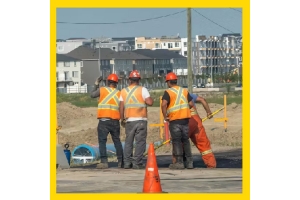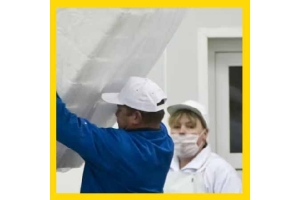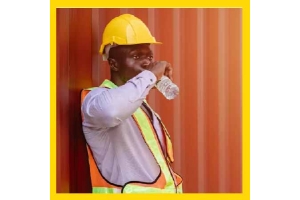Currency
October 03, 2018
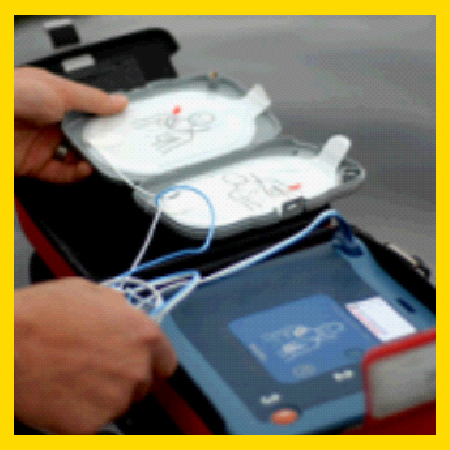
You get to work early because you have a meeting that you want to prep for and, as you do every morning, you take the elevator to the fourth floor. As you exit the elevator, there he is—the longtime and loyal security guard calls out for help, and you see him collapse. Now he is lying face down on the tile floor in the hallway. You know right away that something must be done, and it must to be done fast.
Fortunately, your company keeps an automated external defibrillator (AED) in the main lobby. As you run to get the AED, you call for help, and one of your colleagues emerges from the coffee room. You both run to the guard’s side. You assess the guard; he is not moving and he is not breathing. You recall from your training that he needs CPR and he needs the AED.
What happened to the security guard? What you are witnessing is an adult who is in cardiac arrest. Cardiac arrest is when a person’s heart stops beating, and they stop breathing. This is not to be confused with a "heart attack." A heart attack is when the heart is hungry for oxygen. This can be caused by a blood clot or plaque buildup that blocks blood flow to the heart. If the heart continues to starve for oxygen, it may stop, or arrest. The American Heart Association estimates that each year, there are about 10,000 cardiac arrest incidents in the workplace.
How can you in the situation described above? First, you need to keep a level head and get help on the way. Emergency medical services need to be called using 911. The EMTs and paramedics will bring medications and other devices that can help, but in the meantime, you can buy some time for the security guard. Because his heart is not beating enough to send blood to the brain and vital organs, you are going to do that for him by performing cardiopulmonary resuscitation, or CPR.
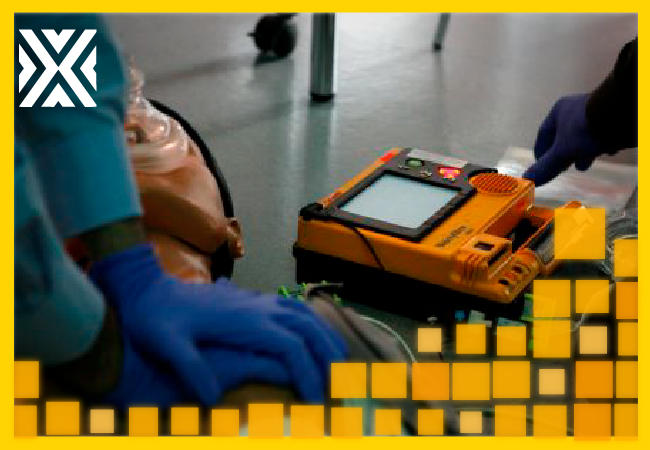
You want to position the victim on his back and expose the chest. Once you have exposed his chest, you are going to place the heel of one hand on the lower half of his sternum, or breastbone. As the heart has stopped, you are going to compress straight down on the victim's chest about 1½ to 2 inches. When you do this, you are squeezing the heart between the sternum and the spine, making the heart "beat." While this is not as effective as a normal heartbeat, you are circulating blood to the victim's brain, lungs, and the rest of his body. You are going to do these compression at a rapid rate of 100-120 compression per minute.
You are buying time by circulating blood throughout the victim's body. According to the AHA, hands-free CPR has been shown to be as effective as conventional CPR performed at work or in public. You also need to attach the AED that you brought from the lobby.
Using the AED Even though the security guard's heart is not beating, there still may be some electrical activity present. Our hearts utilize electricity to beat roughly 60-100 times each minute, for adults. The heart may be quivering with uncoordinated electrical impulses. Because the impulses are uncoordinated, the heart does not push out the blood that the body needs. The AED is a lifesaving tool that can change that. Your colleague is going to attach the AED as soon as possible; even while you are doing chest compression, the AED can be safely turned on and applied to the victim. The large oval or square pads need to be placed like the pictograms on the pads: one toward the upper right region of the victim's chest and the other on the left side of the chest, beneath the heart. When the pads are on properly, the victim's heart is basically in between the two pads.
The AED may identify a condition where the machine will discharge electricity, and the victim’s heart is the target. This large electrical shock is going to "reset" all the cardiac cells at once, and they may pick up with their normal routine with coordinated electrical activity that produces a pulse and delivers blood to the brain and body. Remember, the AED is automated, not automatic. You still need to push a "shock" button if the computer in the AED recognizes a "shockable" condition. If there is no electrical activity at all or if the heart is beating normally, the AED is designed not allow delivery of an electrical shock. The AED will make an audible announcement that says "analyzing now." This is when you need to stop doing CPR, and you need to make sure you or anyone else is not touching the patient. Remember, if there is a faint heartbeat or if there is no electrical activity at all in the heart, the AED will not give the command to charge and shock. Let the AED be the boss for the next few minutes. It will tell you when to do CPR and when to stop so that it can assess the victim. If the AED detects a shockable condition, it will advise you to "push to shock." For your safety, you want to make sure that you or the other people helping you are not touching the victim when he is shocked. You will see the victim's body jerk or move as this electricity is sent through the chest to the heart. The AED will not assess for two more minutes, and you are going to perform CPR for those two minutes.
If there are two or more of you there, be sure to take turns and rotate rescuers every two minutes. To do the compressions are the correct depth (1½- 2 inches) and the correct rate (100-120 compressions per minutes), it can be very fatiguing to the rescuer. Rotate your roles so that every two minutes, there is a rested rescuer who will be ready to provide the necessary compression.
You and your colleagues are the best tools for the job. You are causing the victim's heart to beat because it is not able to beat on its own. There is no guarantee of survival, but you are giving the security guard the best chance in the situation you are in.
Fortunately, your company keeps an automated external defibrillator (AED) in the main lobby. As you run to get the AED, you call for help, and one of your colleagues emerges from the coffee room. You both run to the guard’s side. You assess the guard; he is not moving and he is not breathing. You recall from your training that he needs CPR and he needs the AED.
What happened to the security guard? What you are witnessing is an adult who is in cardiac arrest. Cardiac arrest is when a person’s heart stops beating, and they stop breathing. This is not to be confused with a "heart attack." A heart attack is when the heart is hungry for oxygen. This can be caused by a blood clot or plaque buildup that blocks blood flow to the heart. If the heart continues to starve for oxygen, it may stop, or arrest. The American Heart Association estimates that each year, there are about 10,000 cardiac arrest incidents in the workplace.
How can you in the situation described above? First, you need to keep a level head and get help on the way. Emergency medical services need to be called using 911. The EMTs and paramedics will bring medications and other devices that can help, but in the meantime, you can buy some time for the security guard. Because his heart is not beating enough to send blood to the brain and vital organs, you are going to do that for him by performing cardiopulmonary resuscitation, or CPR.

You want to position the victim on his back and expose the chest. Once you have exposed his chest, you are going to place the heel of one hand on the lower half of his sternum, or breastbone. As the heart has stopped, you are going to compress straight down on the victim's chest about 1½ to 2 inches. When you do this, you are squeezing the heart between the sternum and the spine, making the heart "beat." While this is not as effective as a normal heartbeat, you are circulating blood to the victim's brain, lungs, and the rest of his body. You are going to do these compression at a rapid rate of 100-120 compression per minute.
You are buying time by circulating blood throughout the victim's body. According to the AHA, hands-free CPR has been shown to be as effective as conventional CPR performed at work or in public. You also need to attach the AED that you brought from the lobby.
Using the AED Even though the security guard's heart is not beating, there still may be some electrical activity present. Our hearts utilize electricity to beat roughly 60-100 times each minute, for adults. The heart may be quivering with uncoordinated electrical impulses. Because the impulses are uncoordinated, the heart does not push out the blood that the body needs. The AED is a lifesaving tool that can change that. Your colleague is going to attach the AED as soon as possible; even while you are doing chest compression, the AED can be safely turned on and applied to the victim. The large oval or square pads need to be placed like the pictograms on the pads: one toward the upper right region of the victim's chest and the other on the left side of the chest, beneath the heart. When the pads are on properly, the victim's heart is basically in between the two pads.
The AED may identify a condition where the machine will discharge electricity, and the victim’s heart is the target. This large electrical shock is going to "reset" all the cardiac cells at once, and they may pick up with their normal routine with coordinated electrical activity that produces a pulse and delivers blood to the brain and body. Remember, the AED is automated, not automatic. You still need to push a "shock" button if the computer in the AED recognizes a "shockable" condition. If there is no electrical activity at all or if the heart is beating normally, the AED is designed not allow delivery of an electrical shock. The AED will make an audible announcement that says "analyzing now." This is when you need to stop doing CPR, and you need to make sure you or anyone else is not touching the patient. Remember, if there is a faint heartbeat or if there is no electrical activity at all in the heart, the AED will not give the command to charge and shock. Let the AED be the boss for the next few minutes. It will tell you when to do CPR and when to stop so that it can assess the victim. If the AED detects a shockable condition, it will advise you to "push to shock." For your safety, you want to make sure that you or the other people helping you are not touching the victim when he is shocked. You will see the victim's body jerk or move as this electricity is sent through the chest to the heart. The AED will not assess for two more minutes, and you are going to perform CPR for those two minutes.
If there are two or more of you there, be sure to take turns and rotate rescuers every two minutes. To do the compressions are the correct depth (1½- 2 inches) and the correct rate (100-120 compressions per minutes), it can be very fatiguing to the rescuer. Rotate your roles so that every two minutes, there is a rested rescuer who will be ready to provide the necessary compression.
You and your colleagues are the best tools for the job. You are causing the victim's heart to beat because it is not able to beat on its own. There is no guarantee of survival, but you are giving the security guard the best chance in the situation you are in.
